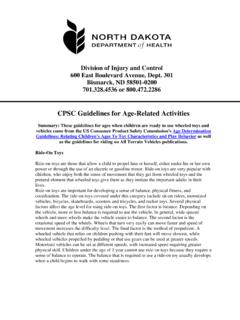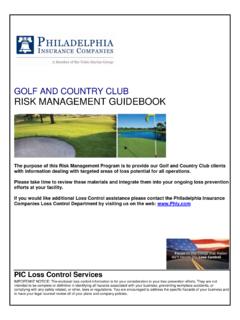Transcription of Public Playground Safety Handbook - eckan.org
1 Public Playground Safety Handbook consumer product Safety commission Saving Lives and Keeping Families Safe TABLE OF CONTENTS. Page No. 1. 1. Scope .. 1. Intended Audience .. 1. What is a Public Playground ?.. 1. Public Playground Safety Voluntary Standards and CPSC Handbook History .. 1. ASTM Playground standards .. 2. Significant Revisions for 2008 .. 2. Equipment guidelines .. 2. Surfacing guidelines .. 2. General guidelines .. 2. Other revisions .. 2. Background .. 2. Playground Injuries .. 3. 3. 2 General Playground 5. Selecting a Site ..5. Shading considerations .. 5. Playground Layout ..5. Accessibility .. 6. Age separation .. 6. Age group .. 6. Conflicting activities .. 6. Sight lines .. 6. Signage and/or labeling .. 6. Supervision .. 7. Selecting 8. Equipment not recommended .. 8. Surfacing .. 8. Equipment not covered by protective surfacing recommendations .. 8. Selecting a surfacing material .. 9. Equipment Materials .. 10. Durability and finish .. 10. 11. Metals .. 12.
2 Paints and finishes .. 12. Wood .. 12. Assembly and Installation .. 13. 3 Playground 14. Crush and Shearing Points ..14. Entanglement and 14. Strings and ropes ..14. Entrapment .. 15. Head entrapment .. 15. Partially bound openings and 16. Sharp Points, Corners, and Edges .. 16. Suspended 16. PUBLICATION #325 NOVEMBER 2010. Handbook for Public Playground Safety Tripping Hazards ..16. Used 4 Maintaining a Playground .. 18. Maintenance Inspections .. 18. Repairs ..18. Maintaining Loose-Fill Surfacing .. 18. Recordkeeping .. 19. 5 Parts of the 20. Platforms, Guardrails and Protective Barriers .. 20. Platforms .. 20. Stepped platforms .. 20. Guardrails and protective 20. Access Methods to Play Equipment .. 22. Ramps, stairways, rung ladders, and step ladders .. 23. Rungs and other hand gripping components .. 24. Handrails .. 24. Transition from access to platform .. 24. Major Types of Playground Equipment .. 24. Balance beams .. 24. Climbing and upper body equipment .. 24. Log rolls.
3 30. Merry-go-rounds ..30. Seesaws ..31. Slides ..32. Spring rockers .. 36. Swings .. 37. Fall height and use zones for composite structure .. 41. Fall height and use zones not specified elsewhere .. 41. APPENDICES. A Appendix A: Suggested General Maintenance Checklist .. 43. B Appendix B: Playground Testing .. 45. Templates, Gauges, and Testing Test Methods ..49. Determining whether a projection is a protrusion .. 49. Projections on suspended members of swing assemblies .. 49. Projections on slides .. 49. Entrapment .. 51. Test fixtures ..52. Handbook for Public Playground Safety 1. INTRODUCTION What is a Public Playground ? Public Playground equipment refers to equipment for use In recent years, it is estimated that there were more than by children ages 6 months through 12 years in the play . 200,000 injuries annually on Public playgrounds across ground areas of: the country that required emergency room treatment. By Commercial (non-residential) child care facilities following the recommended guidelines in this Handbook , you and your community can create a safer Playground Institutions environment for all children and contribute to the reduc Multiple family dwellings, such as apartment and condo.
4 Tion of Playground -related deaths and injuries. minium buildings Parks, such as city, state, and community maintained Scope parks This Handbook presents Safety information for Public play Restaurants ground equipment in the form of guidelines. Publication of Resorts and recreational developments this Handbook is expected to promote greater Safety aware . ness among those who purchase, install, and maintain Public Schools Playground equipment. Because many factors may affect Other areas of Public use Playground Safety , the consumer product Safety commission (CPSC) staff believes that guidelines, rather These guidelines are not intended for amusement park than a mandatory rule, are appropriate. These guidelines are equipment, sports or fitness equipment normally intended not being issued as the sole method to minimize injuries for users over the age of 12 years, soft contained play equip . associated with Playground equipment. However, the ment, constant air inflatable play devices for home use, art commission believes that the recommendations in this and museum sculptures (not otherwise designed, intended Handbook along with the technical information in the and installed as Playground equipment), equipment found ASTM standards for Public playgrounds will contribute to in water play facilities, or home Playground equipment.
5 Greater Playground Safety . Equipment components intended solely for children with disabilities and modified to accommodate such users also are Some states and local jurisdictions may require compliance not covered by these guidelines. Child care facilities, espe . with this Handbook and/or ASTM voluntary standards. cially indoor, should refer to ASTM F2373 Standard Additionally, risk managers, insurance companies, or others consumer Safety Performance Specification for Public Use Play may require compliance at a particular site; check with Equipment for Children 6 Months Through 23 Months, for state/local jurisdictions and insurance companies for specific more guidance on areas unique to their facilities. requirements. Public Playground Safety Voluntary Intended Audience Standards and CPSC Handbook This Handbook is intended for use by childcare personnel, History school officials, parks and recreation personnel, equipment 1981 First CPSC Handbook for Public Playground Safety purchasers and installers, Playground designers, and any was published, a two-volume set.
6 Other members of the general Public ( , parents and school groups) concerned with Public Playground Safety and inter 1991 Standard Specification for Impact Attenuation of ested in evaluating their respective playgrounds. Due to the Surface Systems Under and Around Playground Equipment, wide range of possible users, some information provided may ASTM F1292, was first published. be more appropriate for certain users than others. The 1991 Two-volume set was replaced by a single-volume voluntary standards listed in contain more technical Handbook , which contained recommendations based on a requirements than this Handbook and are primarily intended COMSIS Corporation report to the CPSC (Development for use by equipment manufacturers, architects, designers, of Human Factors Criteria for Playground Equipment Safety ). and any others requiring more technical information. 1. Handbook for Public Playground Safety 1993 First version of voluntary standard for Public play F2049 Standard Guide for Fences/Barriers for Public , ground equipment, ASTM F1487 Standard consumer Commercial, and Multi-Family Residential Use Outdoor Play Safety Performance Specification for Playground Equipment Areas.
7 For Public Use, was published (revisions occur every 3 to 4. F1148 Standard consumer Safety Performance Specification years). for Home Playground Equipment. 1994 Minor revisions to the Handbook . F1918 Standard Safety Performance Specification for Soft 1997 Handbook was updated based on (1) staff review Contained Play Equipment. of ASTM F1487, (2) Playground Safety roundtable meet . ing held October 1996, and (3) Public comment received to a May 1997 CPSC staff request. Significant Revisions for 2008. 2005 First version of voluntary standard for Playground Equipment guidelines equipment intended for children under two years old, ASTM F2373 Standard consumer Safety Performance Age ranges expanded to include children as young as 6. Specification for Public Use Play Equipment for Children 6 months based on ASTM F2373. Months Through 23 Months, was published. Guidelines for track rides and log rolls added 2008 Handbook was updated based on comments Exit zone requirements for slides harmonized with ASTM.
8 Received from members of the ASTM F15 Playground F1487. Committees in response to a CPSC staff request for sug . gested revisions. Significant revisions are listed below. Surfacing guidelines ASTM Playground standards Critical height table revised Below is a list of ASTM technical performance standards Suggestions for surfacing over asphalt added that relate to playgrounds. General guidelines F1487 Standard consumer Safety Performance Specification for Playground Equipment for Public Use. Suggestions on sun exposure added F2373 Standard consumer Safety Performance Specification Other revisions for Public Use Play Equipment for Children 6 Months through 23 Months. Editorial changes to make the Handbook easier to under . stand and use F1292 Standard Specification for Impact Attenuation of Surface Systems Under and Around Playground Equipment. F2075 Standard Specification for Engineered Wood Fiber for Background Use as a Playground Safety Surface Under and Around The Safety of each individual piece of Playground equipment Playground Equipment.
9 As well as the layout of the entire play area should be consid . F2223 Standard Guide for ASTM Standards on Playground ered when designing or evaluating a Playground for Safety . Surfacing. Since falls are a very common Playground hazard pattern, the installation and maintenance of protective surfacing F2479 Standard Guide for Specification, Purchase, under and around all equipment is crucial to protect chil . Installation and Maintenance of Poured-In-Place Playground dren from severe head injuries. Surfacing. Because all playgrounds present some challenge and because F1951 Standard Specification for Determination of children can be expected to use equipment in unintended Accessibility of Surface Systems Under and Around and unanticipated ways, adult supervision is highly recom . Playground Equipment. mended. The Handbook provides some guidance on supervi . F1816 Standard Safety Specification for Drawstrings on sory practices that adults should follow. Appropriate equip . Children's Upper Outerwear.
10 Ment design, layout, and maintenance, as discussed in this 2. Handbook for Public Playground Safety Handbook , are also essential for increasing Public Playground Playground Injuries Safety . The U. S. consumer product Safety commission has long A Playground should allow children to develop gradually and recognized the potential hazards that exist with the use of test their skills by providing a series of graduated challenges. Playground equipment, with over 200,000 estimated emer . The challenges presented should be appropriate for age- gency room-treated injuries annually. The most recent study related abilities and should be ones that children can per of 2,691 Playground equipment-related incidents reported to ceive and choose to undertake. Toddlers, preschool- and the CPSC from 2001-2008 indicated that falls are the most school-age children differ dramatically, not only in physical common hazard pattern (44% of injuries) followed by size and ability, but also in their intellectual and social skills.


